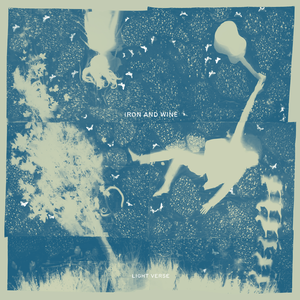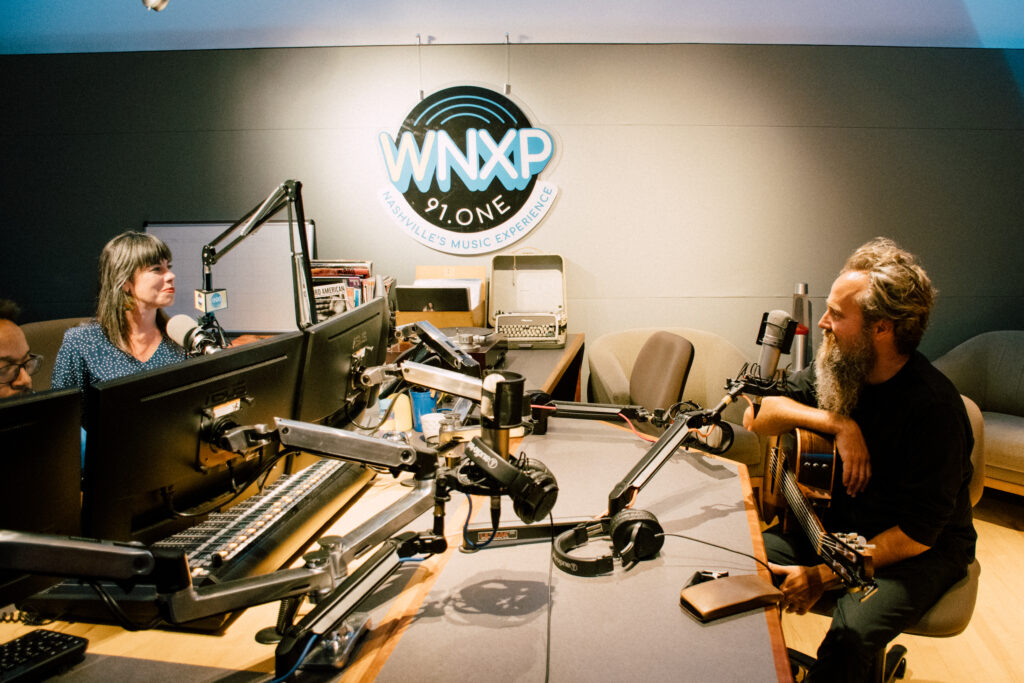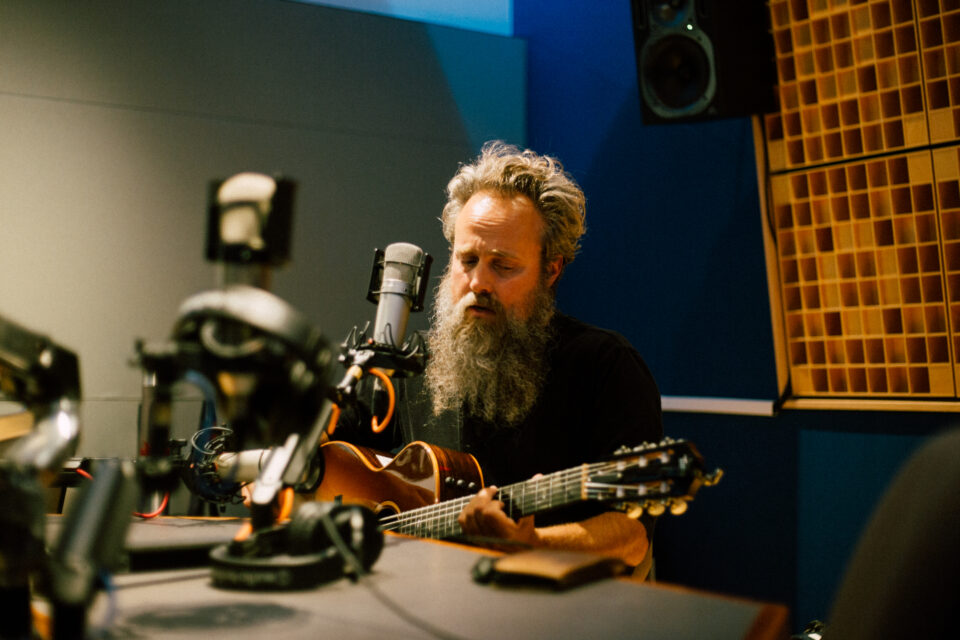
Sam Beam’s visit to Nashville in late April, just days after the release of the seventh Iron & Wine LP called Light Verse, was for a different artistic purpose: to screen at the indie Belcourt Theater the concert documentary “Who Can See Forever: A Portrait of Iron & Wine” made during his tour for 2017 record Beast Epic.
Speaking of the vulnerability required in showing himself so visually in the film, the historically reserved (though super funny) Beam said, “I’m definitely more of a behind-the-camera person. I mean, that’s ridiculous to say as someone who plays concerts for a living, but, you know, that’s kind of its own theatrical space where I don’t really have to reveal a whole lot. And so I kind of treated [the documentary] that way. [Director Josh Sliffe], we were friends, too. I don’t think he was, like, rummaging through my underwear drawer.”
In-studio at WNXP, we discussed the film and the new record, which is now our Record of the Week in advance of Iron & Wine’s next Nashville tour stop, August 24 at the historic Ryman Auditorium. You can hear the exclusive solo acoustic performances of “All in Good Time” and “Anyone’s Game” from Light Verse only on WNXP, and hear the full conversation with Sam Beam both here and on WNXP’s podcast channel.
“I recognize a working momentum as opposed to some flash of inspiration”
After spending most of the years since Beast Epic, including the forced arrest of COVID-19, focusing on family at home in North Carolina (Beam has five daughters), it took the artist a little priming of the pump back on the road to get into a flow again for writing songs.
“I had a hard time concentrating, focusing on music,” he said of period from around 2020 to 2022. “A lot of people fared a lot worse than I did in in the pandemic. But creatively, it was kind of devastating to me. I just don’t create out of that kind of conflict, that kind of anxiety. And so I kind of put those things away and worked on artwork and hung out with my kids, things like that. And then, maybe two years ago, things kind of opened up. I started playing some shows and reconnecting with those. I did a record of like three or four songs of Lori McKenna [called Lori] — she’s a writer, a singer-songwriter that I have a lot of respect for. So I did a couple of her songs and then went on tour with Andrew Bird for a summer and just sort of reconnected with what I love to do…play shows and make records.”
Does this mean that this indie-folk king of sweet, slow, pastoral tunes illustrating the opposite of frenetic activity could only get inspired when in motion? “It certainly doesn’t hurt,” he laughed. “You sort of have to get the muscles back up and working a bit. I mean, it doesn’t mean that’s impossible. I just have been doing it long enough where I recognize a working momentum as opposed to some flash of inspiration. Those are fun, but they don’t show their heads very often. They’re a little squirrely. When you’re in a regular working discipline, a rhythm, I feel more comfortable there.”
It’s all in the “casting”
Having started the Iron & Wine project recording the most hauntingly lo-fi and sparse songs with just his whispery vocal and acoustic guitar (hear the 2002 debut The Creek Drank the Cradle), Sam Beam has since utilized more tools in his creative kit plus the expertise of other musical geniuses to round out the sound on records and on tour, to great effect.
For Light Verse, he recorded with Dave Way at “Way Station” in L.A., enlisting notable SoCal session players David Garza, Tyler Chester, Griffin Goldsmith (of Dawes), Elizabeth Goodfellow and Kyle Crane — some of these overlapping with the band of duet partner Fiona Apple. He also employed a 24-person string orchestra for some songs, with arrangements composed by multi-instrumentalist Paul Cartwright. The whole experience was beautiful but “cost prohibitive, as it turns out,” Beam laughed.
“It’s kind of like movies where 90% is casting…they can take a boring song and make it incredible because of the great ideas that they have,” he said. “So I put a lot of energy into who I give a key to. And I’ve found that those risks usually payoff the best. You know, you can spend a lot of money sitting in a in a studio going over all your plugins and trying to fix things, but I tend to put my energy and resources into people that I trust and love to hear their ideas. The loose cannons are ones that have the best ideas.”
On tour this summer and fall, the Iron & Wine band that features four female instrumentalists who all sing (“It’s going to sound like a cult,” Beam deadpanned) will try to recreate the spirit of these songs if not – as is impossible – the whole tracklist note for note.
Lately I’ve been taking more risks,” he continued. “I don’t polish as much as I used to. It’s much more immediate. There’s a lot more pushing and pulling with beauty and dissonance, chaos and beauty, you know, kind of arm wrestling the whole time. There’s a lot of pushing and pulling with the tempos so it doesn’t feel like a computerized dance track — not that anyone would mistake my music for that — where it almost feels like a human breath. It kind of comes and goes and speeds up and slows down depending on what’s happening in your life.”
Inspiration less geographic, more poetic
About the song “Anyone’s Game,” the second track on Light Verse, Beam cited a left-field sort of muse. “I ran across these poems by this this Serbian poet (he’s not alive anymore) Vasko Popa. He has this series of poems called ‘Games,’ which were so amazing. They’re really short. He has this way of describing life in as though he was describing, like, the rules of a children’s game, like hide and seek or something like this. So they’re in turn really surreal or scary, but also funny. There are maybe only ten poems in the cycle, but they’re so great. I’ve found a couple different translations, and the ones that Charles Simic did are the funniest. He was he was another one of my favorites. So this song was an interpretation of, or sort of inspired by, those poems. It was my sort of homage.
Find Serbian to English translations of Popa’s poems here. And here are American writer Charles Simic’s translations.
Living a life with “no safety ropes”
In the trailer for the “Who Can See Forever” documentary, Beam can be heard alluding to a recognition that life has “no safety ropes.” I asked him to elaborate on the meaning of that for him, maybe implications creatively and/or personally. (Beam is a father of five daughters.)
“I think the older I get, the more I realize how few safety ropes there are. Or it definitely feels like like that. The more experience you get, the more danger you recognize. But also you realize that’s what’s beautiful about some things are the risks that you take, especially with creative work. I mean, the risks are what you end up thinking about, not the safe plays that you made. Creatively, it’s usually when you change something…that’s how we even mark our whole lives, the big changes. And so, yeah, it seems as you get older, you’re much more aware, more leery, but you also understand how important it is to embrace those things.”

Making a duet out of “All in Good Time”
One of the songs Beam had penned for the new record came to a new life when he invited Fiona Apple to sing on it. “All in Good Time” would become the lead single announcing Light Verse. How did this duet come to be?
“She and I share band members,” said Beam of Apple. “Sebastian Steinberg has been playing me for quite a while, and he plays in her band, and David Garza was on the record and plays with her. In fact, the whole reason I ended up at Dave Way’s studio, in, in L.A. was because they had been making the her last few records there, and they were in my ear about how much fun it was. And turns out they were right. It’s really, really great. And so was a family affair, in a way.”
Of the chance to duet with Apple, Beam said “That was amazing to get to have her sing on a record with me. It wasn’t written as a duet…but because it sort of lists these things of this couple, you know, their exploits, as soon as you start trading verses, it just gets a little bit more dramatic. There’s more subtext and the horizon just sort of expands. And so it was fun to try the song that way.”
On the final track, “Angels Go Home”
“It kind of goes different places. One, because it says go home. You know, it’s like time to go,” Beam laughed. “But it also had like a slightly different treatment with the strings…it takes a couple more chances than some of the other songs with strings, it kind of floats in an unguarded way. And so I thought it was a nice, unsettling, but also startling way to go out.”
“I would agree. Let’s float. No safety net,” I said. “Let’s go,” said Beam.

